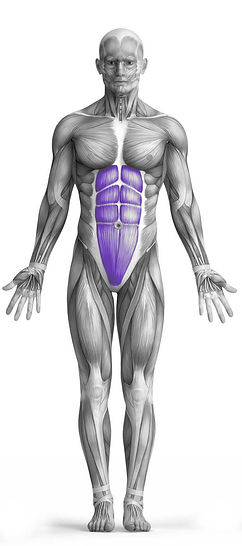Reverse Ab Roll-Out 101 Video Tutorial
0

Exercise Synopsis
Target Muscle Group
Abs
Secondary Targets
Execution
Compound
Force Type
Core
Required Equipment
Exercise Ball
Fitness Level
Intermediate
Variations
None
Alternatives
None
Timer
Hour
Minute
Second
Stopwatch
00:00:00:00
Overview
The Reverse Ab Roll-Out is a dynamic exercise that primarily targets the abdominal muscles while also engaging the lower back. Utilizing an exercise ball for added instability, this exercise involves rolling the ball away from the body while maintaining a plank position with the hands on the ground and the feet on the ball. As the body extends backward, the core muscles are engaged to prevent overarching of the lower back, effectively working the abs. Additionally, the lower back muscles are recruited to stabilize the spine throughout the movement, promoting core strength and stability.
How to Perform
Begin by kneeling on the floor with the exercise ball positioned in front of you.
Place your hands on the floor in front of the ball, shoulder-width apart, and carefully position your shins and the tops of your feet on the ball.
Engage your core muscles to stabilize your torso and maintain a straight line from your head to your knees.
Slowly roll the exercise ball away from your body by extending your arms and allowing your body to lean forward.
Continue rolling the ball out until your body is fully extended and your arms are overhead, keeping your core muscles engaged to prevent your lower back from arching excessively.
Hold the stretched position briefly, feeling the tension in your abs and lower back.
Slowly reverse the movement by pulling the exercise ball back towards your body, using your core muscles to control the motion.
Return to the starting position with the exercise ball under your hands and your body in a kneeling position, maintaining control throughout the movement.
Repeat the exercise for the desired number of repetitions, focusing on maintaining proper form and control to effectively target the abs and engage the lower back muscles.
As you become more comfortable with the movement, you can increase the difficulty by rolling the ball out further or by holding the stretched position for a longer duration.
★ Bonus: For exercises that involve external weights (such as dumbbells, barbells, or machines), the One Rep Max (1RM) calculator can help you estimate your maximum lifting capacity. Use it to track your strength progress and adjust your training for optimal results.
Tips
Start in a kneeling position with hands on the floor and shins resting on the exercise ball.
Engage core muscles to maintain a straight line from head to knees.
Slowly roll the ball away from the body by extending arms forward.
Maintain control as the body extends, preventing excessive arching of the lower back.
Hold the stretched position briefly, feeling the tension in the abs and lower back.
Use core muscles to pull the ball back towards the body, returning to the starting position.
Control the movement throughout, avoiding jerky or rapid motions.
Focus on breathing steadily throughout the exercise to maintain stability and energy.
Keep the movement slow and deliberate, emphasizing muscle engagement.
Gradually increase the difficulty by extending the range of motion or holding the stretched position for longer durations as strength improves.
How Not to Perform
Avoid overarching the lower back by maintaining proper core engagement throughout the exercise.
Do not rush the movement; perform each phase of the exercise with control and precision.
Avoid letting the hips sag or rise excessively during the movement; strive to keep the body in a straight line from head to knees.
Do not rely solely on arm strength to roll the ball; instead, focus on using the core muscles to initiate and control the movement.
Avoid holding your breath; remember to breathe steadily and rhythmically throughout the exercise to maintain energy and focus.
Do not extend the arms too far forward or roll the ball too far away from the body; this can strain the shoulders and compromise stability.
Avoid using momentum to complete the movement; instead, focus on controlled contractions of the abdominal and lower back muscles.
Do not neglect proper warm-up and stretching before performing the exercise; prepare the muscles and joints to prevent injury and ensure optimal performance.
Avoid excessive speed or jerky movements; smooth and controlled motions are key to effectively targeting the abs and lower back.
Do not neglect proper form and alignment; maintain stability and control throughout the exercise to maximize muscle engagement and minimize the risk of injury.
Variations
Variations of fitness exercises refer to different ways of performing a specific exercise or movement to target various muscle groups, intensities, or goals. These variations aim to challenge the body differently, prevent plateaus, and cater to individuals with varying fitness levels.
Alternatives
Alternative exercises in fitness refer to different movements or activities that target similar muscle groups or serve the same training purpose as the primary exercise. These alternative exercises can be used as substitutes when the original exercise is unavailable or challenging to perform due to various reasons such as equipment limitations, injuries, or personal preferences.








